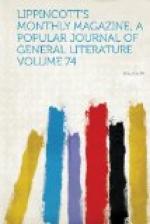At breakfast, Remenyi appeared, a very commonplace-looking man, full of his own praises, and always speaking himself in the third person. “Remenyi practiced well this morning,” said he.
“Yes, a concerto of Bach’s!” Franz.
Thereupon Remenyi asked for his violin, and they heard a marvelous specimen of real Tzigany inspiration. Vanity disappeared—passion, nerve and sentiment took its place. He had all the qualities demanded by science, together with those of imagination. It was the passionate inspiration of genius. After his performance was over, he went gravely to the mantelpiece, stopped the clock, and said to the master of the house, “Let this hand mark for ever the hour when Remenyi played at your house.”
M. Franz taking no pains to disguise; his admiration, Remenyi, gratified by it, invited him to accompany him home. Wherever he went he received a perfect ovation. At one place he ordered a pair of boots, which were sent home, paid for by the municipality. Art is a national glory in Hungary, especially that of the gypsies, which has taken root in the very heart of the soil.
Remenyi’s house at Rakos-Palota, near Pesth, is a long, rambling building, the courtyard of which is given up to chickens, ducks and pigs. M. Franz says the poplars before the door look like exclamation-marks, and he thinks they are planted there to serve as such. There are heaps of rare and precious objects of every imaginable description—all gifts—but the ones which the owner shows with most pride are his Hungarian sabre and a pair of boots which Liszt wore when a child.
The question is often discussed in Hungary whether the national Hungarian music is the production of Tzigany genius, or whether the gypsies are only the exponents of what properly belongs to Hungary itself. The gypsies are proved to have been in Hungary as early as the thirteenth century, and their musicians were celebrated in the sixteenth, some of their names still living in the memory of the people. What has been preserved of genuine old Hungarian music (some melodies of Timody Stephens) has no charm save its antiquity. These and other facts—but, above all, the impression produced on him by the music itself—have convinced M. Franz that the gypsy faculty is one not only of execution, but creation. Gypsy art proceeds from the sentiment, the genius, of the Tzigany race. It is too strange, its elements are too wild, to be the exclusive product of a thoughtful, wise, believing, practical and civilized people; but the Hungarians have understood this art—they have surrounded it with love and respect. Gaining new life, warmth and vigor from the welcoming applause of Hungary, it belongs to her by virtue of her admiration and sympathetic tears.
E.C.R.




